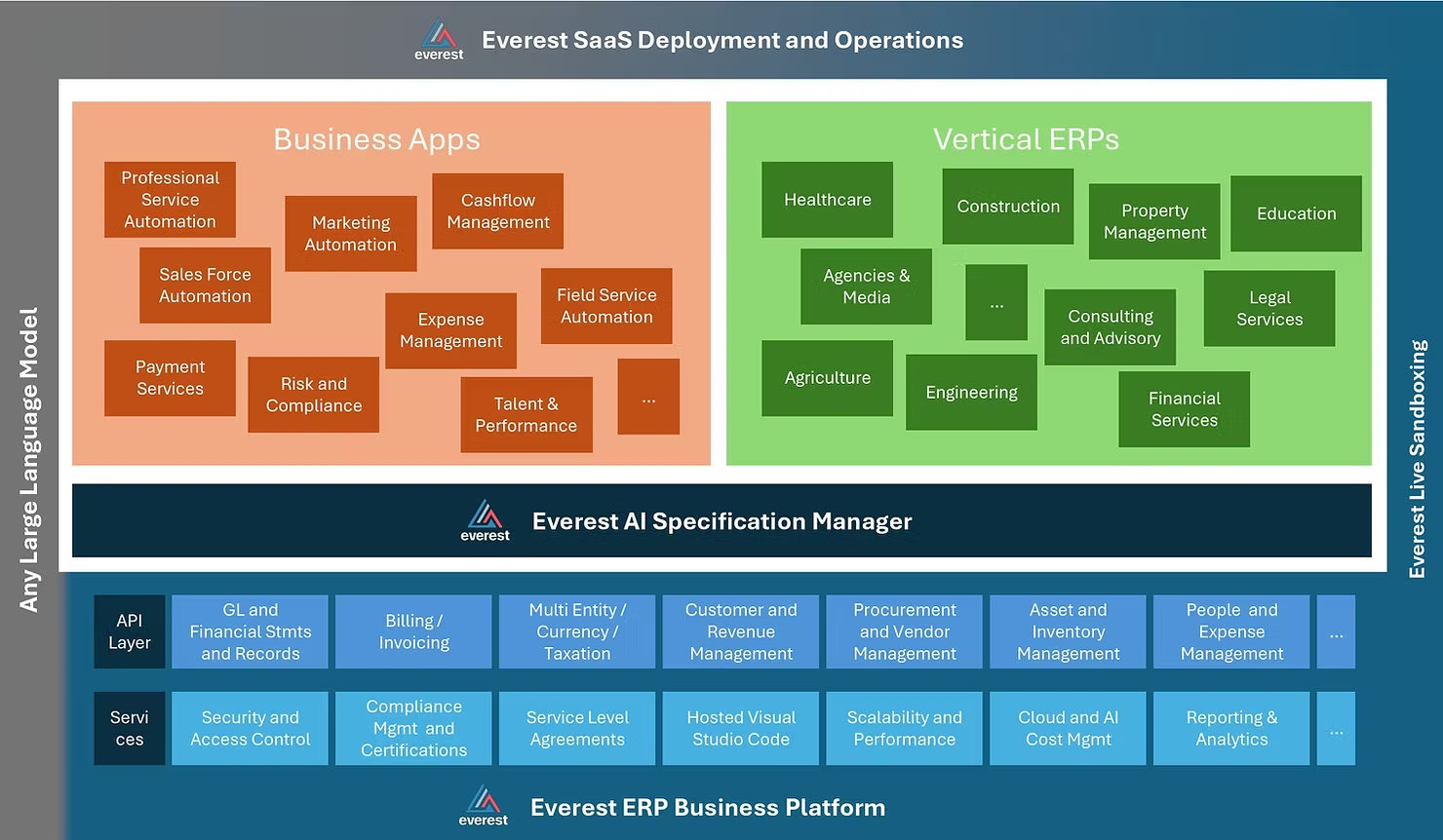The enterprise software landscape is undergoing a profound transformation driven by artificial intelligence. This revolution is reshaping how businesses approach software development, moving from generic one-size-fits-all solutions toward precision-engineered, industry-specific applications. This comprehensive analysis examines three interconnected dimensions of this transformation: the renaissance in software specification, the precision revolution in enterprise applications, and the emergence of vertical ERPs powered by AI platforms.
The Dawn of Precision: Beyond "Vibe Coding"
The software development world has been captivated by the emergence of "Vibe Coding"—a paradigm where developers articulate desired functionality in plain language, and AI assistants handle the complex task of code generation (see https://en.wikipedia.org/wiki/Vibe_coding). Andrey Karpathy, the inventor of the term, has recently talked about this: https://www.youtube.com/watch?v=LCEmiRjPEtQ. This approach has democratized software creation, making it accessible to entrepreneurs, designers, and domain experts who lack traditional programming backgrounds, while promising unprecedented speed in prototyping and developing Minimum Viable Products (MVPs).

However, as the initial excitement settles, a critical question emerges: Is a good "vibe" enough for enterprise-grade software? The answer increasingly points toward a renewed and arguably more critical role for detailed software specifications—a renaissance powered by AI itself. A very similar conclusion has recently been drawn by Forrester researchers in an interesting study by the telling title "AI, AppGen, And The End Of Software Development As We Know It - Application Generation Is The Next Stage Of Software" (see https://www.forrester.com/report/ai-appgen-and-the-end-of-software-development-as-we-know-it/RES184103)
The Limitations of Conversational Development
While vibe coding excels at rapid prototyping, it encounters substantial headwinds when faced with the complexities of enterprise-grade software. Research reveals significant limitations in AI performance during multi-turn conversations. A pivotal study, "LLMs Get Lost In Multi-Turn Conversation," (see https://arxiv.org/abs/2505.06120) demonstrates that 15 large language models exhibited an average performance drop of 39% in multi-turn settings compared to receiving comprehensive instructions upfront.
The implications are clear: providing comprehensive, well-thought-out specifications upfront leads to significantly better results in AI-driven code generation for complex tasks. When AI systems take a "wrong turn" in conversational development—misinterpreting an instruction or heading down an incorrect logical path—they struggle to recover, even when subsequent turns provide clarifying information.
The Specification Renaissance
This limitation has catalyzed a renaissance in software specification, where these once-static artifacts are becoming dynamic, intelligent, and central to software creation. The most significant game-changer is the establishment of true "data binding" between specifications and source code—a link that was conspicuously absent in traditional methodologies.
Modern AI code generation tools can now ingest detailed specifications encompassing functional requirements, non-functional constraints, data models, user interface guidelines, and business rules, using them as executable blueprints for generating application code. With this dynamic, AI-mediated link in place, the human-readable, business-aligned specification emerges as the primary artifact of intellectual property and the verifiable "ground truth" for the software system.
The End of Off-the-Shelf Dominance
For decades, enterprises have navigated digital transformations largely through commercial off-the-shelf (OTS) software. These standardized suites promised efficiency, integrated processes, and best practices. However, the reality for many organizations has been persistent frustration with the inherent limitations of one-size-fits-all solutions.
The Hidden Costs of Generic Solutions
The dissatisfaction with OTS software stems from multiple sources:
Feature bloat: Companies pay substantial licensing and maintenance fees for vast arrays of functionalities they simply don't use
Critical gaps: These same packages frequently lack crucial capabilities essential for specific operational workflows
Strategic limitations: Generic software makes it inherently difficult to achieve unique competitive advantages
Value leakage: The confluence of paying for unused features while lacking essential ones results in significant strategic impediment
As much as 65% of total software costs occur after initial deployment, creating escalating long-term financial burdens. More critically, when a company's key operational processes are managed by generic software, differentiation becomes nearly impossible.
AI as the Catalyst for Customization
AI is not merely an incremental improvement—it's a disruptive force rewriting the economic and practical considerations of custom application development. AI-powered coding tools are revolutionizing software development by automating code generation, suggesting improvements, and handling repetitive programming tasks. This automation translates directly into reduced manual labor and shorter development hours, with analyses suggesting potential savings of up to 30% from custom development costs.
Hyper-Personalization and Precision
AI's comprehensive assistance across the entire software development lifecycle—from understanding nuanced needs to generating precisely tailored code and automating rigorous testing—means software can now be "fully tailored to specific needs" with unprecedented precision and efficiency. This establishes a continuous improvement cycle, a virtuous feedback loop where business processes and the software supporting them co-evolve with ever-increasing efficiency and effectiveness.
The Verticalization Imperative
The modern enterprise operates in an environment of relentless change and escalating complexity. Businesses increasingly recognize that generic Enterprise Resource Planning (ERP) systems, even when subjected to extensive customization, often fall short of addressing the nuanced operational, regulatory, and competitive demands unique to their specific industries.
Traditional Barriers to Vertical ERPs
The traditional path to creating or extensively customizing ERPs for niche markets has been fraught with substantial challenges:
Prohibitive costs and frequent overruns: Consuming vast financial and human resources with no guarantee of success
Integration complexity: Heavily customized systems become difficult and expensive to upgrade
Domain expertise scarcity: The persistent lack of deep industry knowledge compounds development challenges
High risk tolerance requirements: Many potential solutions never reach market due to technical or financial barriers
The AI-Platform Paradigm
The convergence of mature, extensible ERP platforms, sophisticated AI-driven specification tools, and advanced AI code generation capabilities is heralding a new, economically viable paradigm for developing vertical ERPs. This approach leverages:
Extensible Core Platforms: Modern platforms provide standardized, pre-built functionalities that are robust and reliable, handling critical non-functional requirements like scalability, security, and compliance centrally.
AI Specification Management: Tools like Everest Systems' AI Specification Manager act as the linchpin for translating deep, often nuanced, industry-specific knowledge into structured, unambiguous formats that AI code generation engines can effectively understand and act upon.
Ecosystem Effects: This model fosters powerful network effects—a strong platform attracts more developers of vertical solutions, which attracts a larger end-user base, which in turn attracts even more vertical solution developers, creating a virtuous cycle that benefits all participants.
Economic and Competitive Transformation
The AI-platform approach dramatically reduces time-to-market, compressing development lifecycles from years to potentially a fraction of that time. This model enables hyper-specialization and niche dominance, making it feasible to deeply address specific pain points, workflows, and regulatory requirements of increasingly narrow industry segments or even micro-verticals.
The reduced cost and effort of verticalization make it economically viable to create highly specialized ERPs for previously overlooked ultra-niche industries. True domain expertise, meticulously captured and structured within AI specifications, becomes the defining competitive factor rather than technical implementation prowess.
The Future of Enterprise Software
This transformation represents more than technological advancement—it's a strategic revolution demanding proactive adjustments in governance, talent development, and overarching IT strategy. Organizations must develop new competencies:
Evolving Skill Requirements
AI fluency: Understanding how to effectively collaborate with AI systems
Domain specification expertise: The ability to translate complex business logic into AI-consumable specifications
Strategic orchestration: Managing AI-driven development processes and ensuring business alignment
Organizational Transformation
The strategic imperative for IT is transitioning into an enabler and governor of business-led, AI-driven solution development, fostering an internal ecosystem of innovation and value co-creation. This shift enables enterprises to differentiate themselves in ways that were previously impractical or prohibitively expensive.
Conclusion: Precision-Engineered Competitive Advantage
The future of enterprise software is specialized, composable, and undeniably AI-accelerated. By enabling the creation of applications precisely engineered to unique business needs, this new paradigm allows enterprises to differentiate themselves through software that directly reflects their strategic vision and operational excellence.
The future belongs to those who can wield this new capability with precision and strategic foresight. Organizations that embrace detailed specification practices, leverage AI-powered platforms, and develop domain-driven customization capabilities will create sustainable competitive advantages in an increasingly digital economy.
This revolution dismantles traditional barriers between business requirements and technical implementation, creating a world where software becomes a direct expression of business strategy rather than a compromise with generic solutions. The transformation from vibe coding to vertical ERPs represents nothing less than the democratization of precision in enterprise software—where every organization can access software as unique and sophisticated as their business demands.
Check out the Everest AI Specification Manager.
Landing page: https://everest-erp.ai/
Direct access: https://ai.everest-systems.com/




